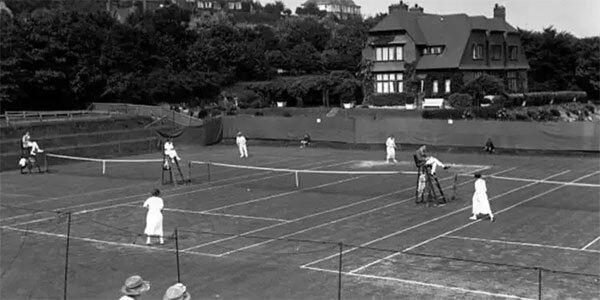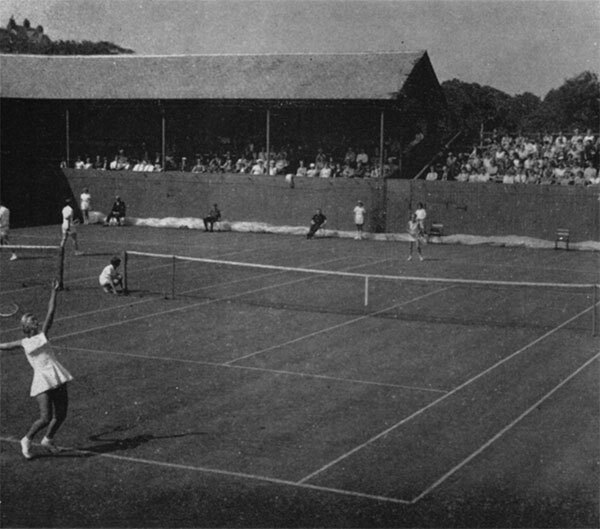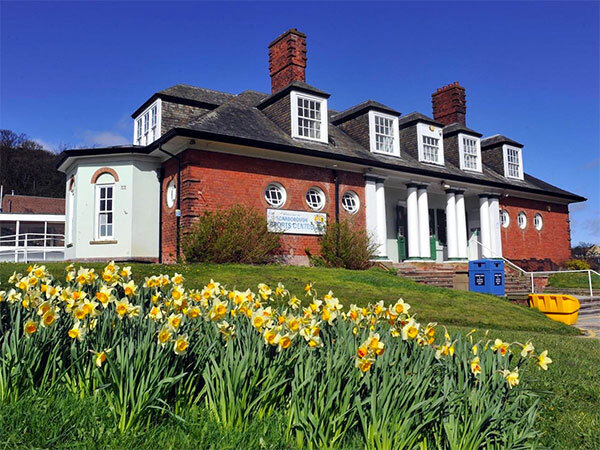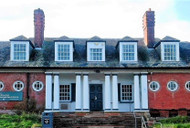
The Scarborough lawn tennis courts in 1922.
It is easy to overlook local history when you are in essence serving a global customer base online, but it kind of seems apt to throw in some local racket sports nostalgia from sunny Scarborough, Atom Retro's home and headquarters. Not to mention that we also stock the iconic Fred Perry clothing brand (Fred Perry, a man who’s affiliation to tennis needs no explanation) bedazzling the patrons of our Malton store as well as our customers online.
Scarborough Tennis: A brisk backhand down the line to re-live the faded glory…
Lawn Tennis in Scarborough is, I think it would be fair to say, a distant memory in these days, a remnant of a rich Victorian culture, the buildings of which have sadly succumbed to neglect, decay and the changing times of our seaside town. But, like a bright yellow tennis ball bouncing free from the dilapidated ruins of the once magnificent Grade II listed Club House, we shall aim to rekindle some past glories of the once revered Scarborough Tennis Club on Filey Road (and indeed its predecessor on South Cliff) and serve up a volley of nostalgic tales to satisfy the vintage soul.

Smashing Time...
At one stage considered the prime location for Yorkshire tennis, Scarborough was also once upon a time privileged enough to host International Standard Tennis tournaments. In fact, in 1958, five of Britain’s Davis Cup ties were held in Scarborough.
From the mid-1880s, Scarborough hosted the prestigious Northern English Championships (though at that time, the tournament took place at South Cliff Tennis Club). The six time grand slam winner (5 Wimbledon titles in consecutive years between 1902 and 1906) and Double Olympic Gold medalist (1900 Olympic Games), Laurence Doherty played in Scarborough, winning the All England Championships Singles Title for under 16’s aka the Renshaw Cup in 1892.
In 1901, 1909 and 1910 respectively, Doherty won the North of England Championships at Scarborough. Doherty was ranked number 1 in the world in 1898.
The blustery and rather exposed South Cliff Tennis Club that overlooked Scarborough’s South Bay witnessed another tennis great in Dorothea Douglass, who would go on to win 7 Grand Slam titles at Wimbledon. She also won the gold medal in the Singles tournament at the 1908 Olympic Games. Dorothea Douglass, like the aforementioned Doherty won The North of England Championships in Scarborough in 1901.
Other notable names to have graced the courts at Scarborough include Lew Hoad, Ken Rosewall, Pancho Segura, Pancho Gonzales, Jack Kramer, Don Budge and Tony Trabert. Dan Maskell appeared in Scarborough as both a player and commentator. In 1953, Pancho Segura defeated Frank Sedgman in the final of the Slazenger Pro Championships, an event that at the time had been dubbed ‘the pro-Wimbledon’ by the media. At its peak, the grass court at Scarborough had been considered by some spectators to be on a parr with that of its Wimbledon counterpart.
Fred Perry at Scarborough
“I didn’t aspire to be a good sport… Champion was good enough for me”…
Long before Fred Perry Clothing arrived resplendent to delight customers at our Newgate, Malton shop (thanks to the deft touches on the dazzling Fred Perry M3600 polo and the Made in England M12 polo shirt), Fred Perry, the man was wowing the crowds on the lush grass courts of Scarborough’s Tennis Club on Filey Road.
In July of 1948, Fred perry won the Slazenger Pro Championship at Scarborough defeating Yvon Petra in 4 sets. Petra had the won Wimbledon Men’s singles title two year prior. Of the match, one observer said, “Fred Perry had lost none of his zest, sting – or shrewdness”. Perry had assessed his opponents game whilst losing the first set and ruthlessly went on to claim the next three. “I knew a little bit more about the game than he did”, said Fred Perry afterwards.
In 1949, aged 40, Fred Perry returned to defend his title in Scarborough. On this occasion he lost in the quarter finals to Australian, Dinny Pails. Pails had won the Australian Championships Men’s Singles Title in 1947.
…And then again in August 1950 Fred Perry returned to Scarborough and was triumphant once more. He beat Egyptian, Salem Khaled in the final. Khaled went on to get some revenge on Fred Perry in 1956 when he beat him in second round of the Professional Lawn Tennis Tournament at Scarborough. The New York Times referenced the result in their August 1st 1956 newspaper. Fred Perry would have been 47 years old at this time. Fred Perry’s last Championship victory in Scarborough was in 1951 when he defended the title he’d won the year previous by defeating Italian, Francesco Romanoni in the final.
One story from a spectator watching Fred Perry at Scarborough recounts Perry showcasing his famed athleticism and poise during a match whilst wearing his pristine white flannels. Perry it is observed then proceeded to consume tea and cakes. Nothing wrong with a bit of tennis alongside a spot of elevenses.
I believe it is correct to say that Fred Perry holds the record for the most Slazenger Pro singles titles at Scarborough with three. Whilst Australian Peter Cawthorn also won three Slazenger Pro Titles, two of these were achieved when the tournament was switched to Eastbourne.
Scarborough held the Championships from 1946-1954 and then again in 1957 with Eastbourne holding the tournament between 1955-1956 and then 1958-1964. The tournament was abolished in 1964, so Fred Perry’s record at Scarborough will never be bested!
A further foray in tennis at Scarborough
It was noted in 1921 by the newly appointed referee at the North of England Championships that the two show courts at Scarborough’s Filey Road Tennis Club were among the finest he had seen on his travels. He commended the clever design that shielded the courts from the wind. He would describe the play at the tournament that year as the best he had seen outside of Wimbledon.
It was the decade post WWII that really defined Scarborough as a tennis destination. The immaculate grass courts placed the venue on a par with much larger places. When the newly created event for professional players (the Slazenger Pro Championships) launched it was in Scarborough and Fred Perry’s 1948 victory over France’s Yvon Petra pitted two legends of the game together. Petra was notable because he was the first post war winner of Wimbledon in 1946. Fred Perry of course needs no further introduction!
The decline of tennis in Scarborough...
… and then like a swift and precise forehand across the face, tennis in Scarborough was gone… resigned to the annals of the tennis history. No more tales to regale and no more points to be won.
In truth the demise of tennis in Scarborough was perhaps a little more gradual. Top players began to favour other European tournaments after play at Wimbledon had finished for the year, the lure of Scarborough no longer so strong. When the Slazenger Pro Tournament left Scarborough for Eastbourne for good in 1958, the North of England Championships were also sadly in decline. These Championships which had thrived at Scarborough between 1884-1909 at South Cliff and then between 1910-1966 (then again for the last time in 1968) at Filey Road’s Yorkshire Lawn Tennis Club would eventually be discontinued in 1974 (by this time the tournament was held in Holylake in Cheshire). The nail in the coffin for Scarborough as a tennis venue was when plans were approved to turn the site in to a multi-sports leisure centre, a move which was not in tune with those at the helm of British Tennis at the time. This led to the North of England Championships being relocated and ensured Scarborough’s status as the regions premier tennis venue was lost.
About the Club House
Renowned Architect, Sir Edwin Cooper designed the Club House in 1910 and it was completed in 1912. The building encompasses elements of Arts and Crafts and Art Deco influences.

Local newspaper, the Scarborough Mercury reported on the new club house in 1911, describing the various rooms including a central hall, men's and women's changing rooms, kitchen, members' room, public room and committee room, with a veranda from which 'people will be able to watch play on various courts'.
From 1913, the North of England Hard Court Championships were held at the club and a new grandstand was opened in 1920. A turret was also added to centre of the Clubhouse from which all courts could be viewed. The former player and well known commentator, Dan Maskell (mentioned above) commentated from the turret. The building is Grade II listed as a building of architectural merit, associated with Lawn tennis which is nationally rare.
So, with its building neglected and it’s courts overgrown, has Tennis in Scarborough been served it’s last strawberries and cream, out of season and frozen in time.
Has over 100 years of Tennis heritage being declared out by the umpires that be. Perhaps not. New plans indicate that whilst residential housing forms part of the proposal, the Club House which has listed status must be preserved. Sport England are also insistent that the Lawn Tennis Courts are to be kept intact as part of any redevelopment plans.
As this particular set comes to a close, let’s serve one last ace and discuss in more depth Fred Perry the man and Fred Perry the clothing brand…
Fred Perry
“I was generally regarded as the best dressed player of my time."
Fred Perry is one of the undisputed all time tennis greats. He also founded one of Britain’s most durable and iconic clothing brands. Fred Perry is the very definition of a heritage brand.
“I am a great believer in trying to look the part. It’s a fetish with me."
The Fred Perry M3 Polo: Pure Fred Perry. Designed by the man himself. Worn by the man himself. In 1952 the M3 fused practicality and wearability both on and off the courts. The pristine one colour design, simple and streamlined silhouette and lightweight functionality makes this polo timeless. As relevant today as it was in 1952.
The M12 Tipped Polo: The original twin tipped Fred Perry Shirt and the style that took Fred Perry from sportswear to streetwear. A piece of subcultural uniform since the 1950s, adopted by each generation as their own.
The M3600 Tipped Polo: A contemporary adaptation of Fred Perry's famous streamlined fit. An interpretation of the original Fred Perry twin tipped polo shirt, the M3600 incorporates a slightly closer fit and comes in a huge array of colours. It comes with a history and each new generation adds to the legacy of this iconic Fred Perry piece.
Fred Perry’s first foray into clothing came when he invented the sweatband with business partner Tibby Wegner. Loosely based on Wegner’s idea, though Fred Perry was not a fan.
The original concept was a large towelling strap which Fred Perry (the best dressed man in tennis) thought resembled a bath towel and weighed a ton. Fred Perry utilised his tennis expertise and recalled his days of wearing medical gauze round his wrists in his Wimbledon days. He did this to prevent sweat from dripping down and affecting his grip.
With Wegner’s textile knowledge and Perry’s tennis expertise, the pair came up with the lightweight and pliable sweatband that we all recognise today. After receiving the prototype from the factory in Leicester, they put in a healthy order and began sending the item out as gifts. Before long the sweatband was being worn by the best tennis players around the world. It is thanks to the humble sweatband that the Fred Perry sportswear brand was born – from a simple tennis accessory to an instantly recognisable and enduring British brand.
The sweatband as well as the instantly recognisable polo shirts became part of sub-cultural uniform. Joe Strummer’s interpretation of the sweatband became known as the Strum-Guard. Paul Weller also sported the accessory in his days with The Jam.

